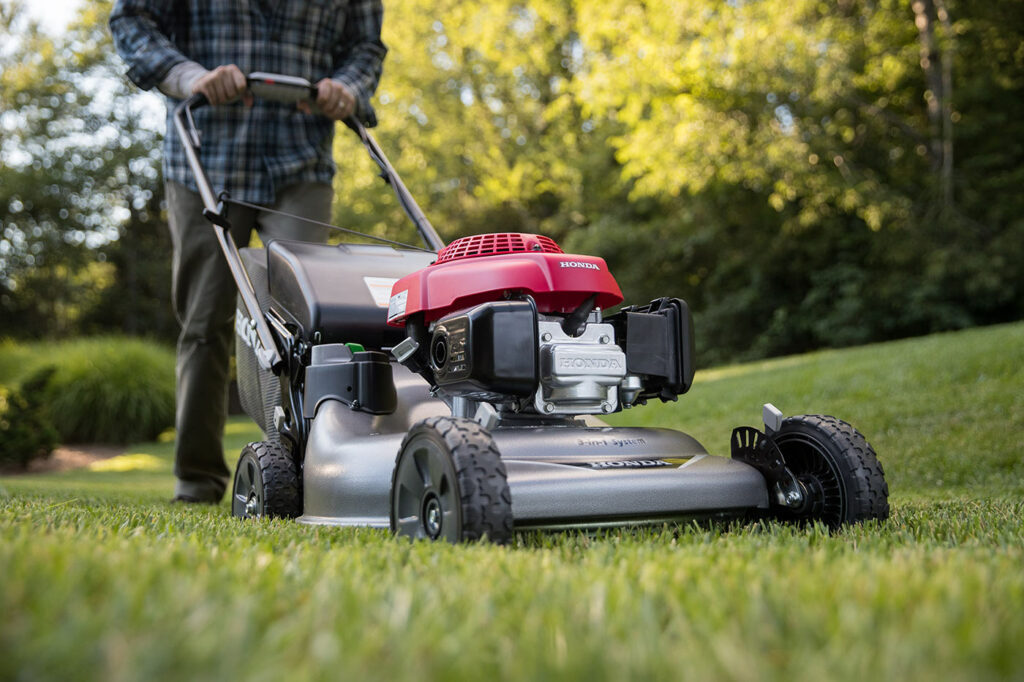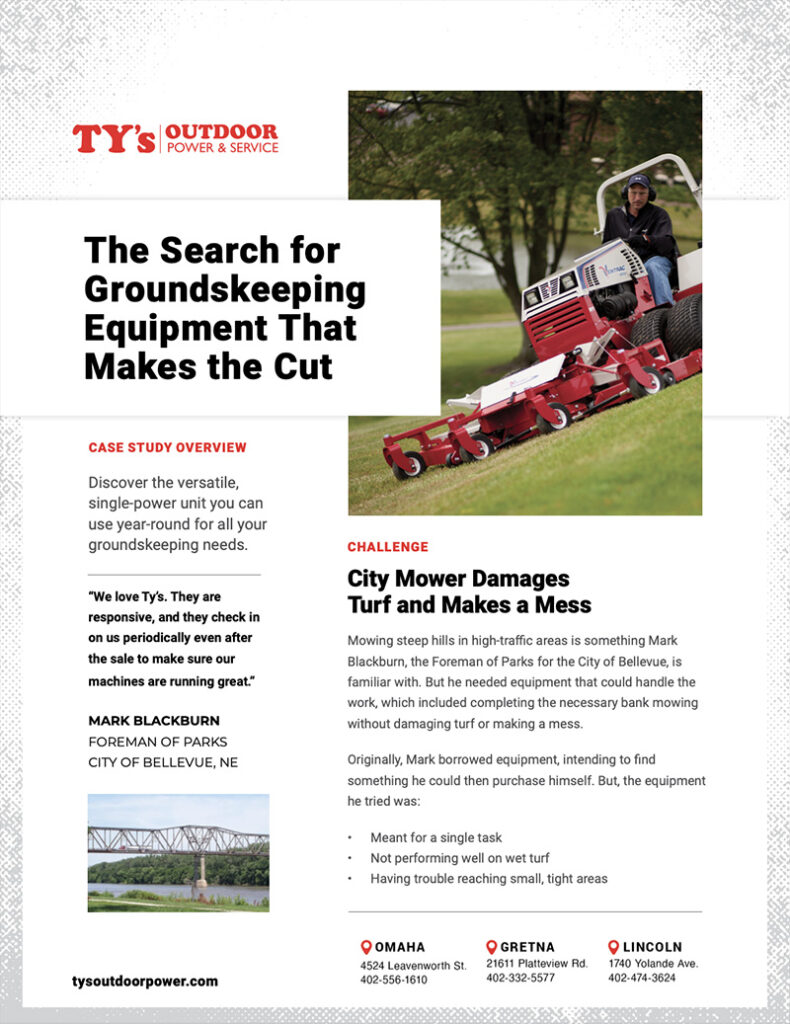Whether your lawnmower is a walk-behind mower, a zero-turn mower, or some other type, mower winterization is crucial to keep your equipment running at its peak for years to come. The colder months bring a lot of extra moisture that can pose the risk of damaging equipment that contains mechanical parts that shouldn’t get wet, including lawnmowers. But once you learn to store your mower the right way, you don’t have to fear the winter months and the potential for damage.
Proper mower winterization requires a little bit of patience and consistency; after all, once you put your mower away for the season, you want to know that when springtime comes, you’ll be taking it out in the best shape possible. It’s all about longevity and keeping your equipment around for as long as you can, without having to replace a part (or worse, the entire mower) because it wasn’t stored properly.
With that in mind, let’s go over the essentials of keeping your mower safe from the elements in the winter season with these winter storage tips.
Clean up mower
The first step toward effective mower winterization is to ensure all the components are clean and free of any debris.
A leaf blower and/or an air compressor are good tools to use for this. Clean up accumulated grass and chaff from around deck pulleys and the engine. Pay attention to the cooling fins under the engine shrouds and the areas around the muffler. If the engine has clean out ports for cleaning the cylinder cooling fins, now is a great time to blow them out and make sure the fins are clear. Mice love to build a nest under the engine shrouds on top of the cylinder. This will block the cooling air and could cause major engine damage.
Carefully raise the mower to access under the deck (or turn walk mowers on their side with the air filter up) and scrape the accumulated grass and debris from the deck. Spray with a nonstick deck spray to protect the metal surfaces. Now would be a good time to sharpen the mower blade(s).
Change the air filter(s)
Filters are what keeps harmful particles away from your mower’s critical components, and even those protectors need to be replaced from time to time, especially if you won’t be using your mower for a while.
Inspect your engine’s air filter(s). If it is at all questionable, replace it. Compressed air can blow a hole in the paper element, so resist the urge to blow the filter out and reuse it. On that note, a partially used air filter cleans better than a brand new one.
Change the engine oil and filter
With any type of mower (including zero-turn mowers), it is best practice to change all the fluids before you store it for the winter. When an engine runs, it is normal for some combustion byproducts to end up inside of the crankcase. Some of these form acids which can etch metal parts during the winter storage. Warm up the engine before you change the oil (warm oil flows better and brings impurities with the oil as it drains. Change the oil filter if your engine is equipped with one. We like to fill the oil filter with oil before installing it to get oil to the critical parts sooner upon restarting. Use a small engine oil (they contain zinc) with the correct viscosity (see owner’s manual) and refill the crankcase. Test run engine and top off the oil level.
Change/Inspect transmission oil levels
Check with your owner’s manual for recommended transmission oil change intervals. Some mowers have a filter change requirement after break-in and some leave it alone until first service. Servicing the transmission(s) now will take a load off of springtime duties when it is time to mow.
Fuel System maintenance
Fuel can harden, stain, and even damage your mower over long periods of time. For example, fuels with ethanol (which contains alcohol) can dissolve plastic parts of your mower’s fuel systems and corrode certain metal parts of systems that are critical to keeping your mower running. So, it’s extremely important to maintain your fuel system for winter storage.
There are three options for fuel system storage:
- The first is to drain the fuel from the tank(s) and the engine carburetor (or run the unit out of fuel), dispose of the fuel properly, and put some synthetic fuel into the tank. Run the engine until the synthetic fuel is in the carburetor and store the equipment with this synthetic fuel in it. This method will keep the fuel system wet and keep certain parts from drying out during storage. Synthetic fuel does not evaporate as easily and that is what leads to extended storage times. Some fuels can get you a 2 year storage period.
- The second method is to treat the fuel system with a fuel stabilizer. If your fuel in the equipment is less than 30 days old and does not contain ethanol, adding a fuel stabilizer to the fuel tank(s) and running the engine to get the treated fuel into the carburetor is a good short term storage method to get through the winter storage.
- The third method is empty the fuel system. If your fuel is less than 30 days old and does not contain ethanol, add a fuel stabilizer to the fuel system. Test run the equipment to get the treated fuel into the carburetor. Run the engine out of fuel and as it is dying, use the choke to keep it running to use up as much fuel in the carburetor as possible. After it dies, try to restart it with the choke on to pull out as much fuel as possible from the carburetor bowl. It would be best to clean out the carburetor bowl as there is a bit of fuel left after it dies. What is left is treated and should make it through the winter storage period. This method should give the longest storage time if you clean out the carburetor bowl because the fuel system is completely dry, good for long term storage.
Now is a good time to change the fuel filter (if equipped) and the EVAP filter (if equipped). Following these steps will help keep your mower’s fuel system prepped for next mowing season so it’s fresh and ready to go come springtime.
Check the spark plug
Mowers are similar to cars in that if your mower’s spark plug isn’t in tip-top shape, you’re going to have a hard time getting it started — and no one wants to take their mower out in the spring and have it not start! That’s why it’s always smart to check the spark plug before you stow the mower for winter.
When you’re checking the spark plug, make sure it’s as clean as possible. Think of it like a car battery: It should be free of debris to ensure a good connection so there’s nothing getting in the way of it doing its job. Specifically, you should be looking for carbon buildup; if you see any replace it, and then follow your mower’s user manual to adjust the electrode cap to the correct specification.
Before reinstalling the spark plug(s), squirt a ½ tablespoon of engine oil into each spark plug hole. Install the spark plug. Turn the engine over a few revolutions without starting it. This will distribute some oil in the cylinder(s) for storage.
Remove any batteries
When you’re storing your mower away for a few months, removing the parts that have their own lifespan can come in handy — especially batteries. If your mower has a battery and you remove it before you store the mower, you’ll preserve the battery’s life while also reducing the risk of battery erosion corrosion negatively affecting your mower. After all, there’s nothing worse than taking your mower out of storage and realizing battery acid has leaked all over it. Certain mowers can cause the battery to go dead during storage of the battery is not disconnected from the mower.
Once a month, give the battery a full charge. Batteries that go dead and then freeze can break the case of the battery. This will ruin the battery and require replacement. Be sure to clean up any corrosion on the cables now with a mixture of baking soda and water so they are ready for connection come spring.
Choose the right storage space
Once you have your lawnmower in tip-top condition, it’s time to store it! If you live or work in an area that’s prone to a lot of snow, it’s smart to store your mower out of the elements. Even if you don’t get a lot of snow in your area, nature always has a way of doing unexpected damage, whether it’s nibbling squirrels or harsh wind and rain.
A storage space that’s indoors, away from harsh sunlight, animals, and storms, is always your best bet. If you use a shed, be sure it has solid walls where no critters or moisture can get in. Consider mouse poison blocks near your mower in storage (see note above about mouse nest plugging cooling fins). Above all, the most important factor to consider is dryness. You’ll want to choose someplace with minimal risk of flooding or leaky pipes, because one thing a mower is not built to withstand is long-term water damage. We can’t stress it enough: Always opt for the driest possible storage space for your mower.
And once your mower has been stowed away, don’t forget to check in on it from time to time to make sure everything looks OK — especially if you experience a big storm or something causes damage to your shed or garage. Always take the time to check in, because if you don’t and something happens, you may discover the damage far too late.
What about other lawncare equipment?
Chances are your lawncare arsenal isn’t limited to just a mower. If that’s the case, you may be wondering how to winterize your other equipment. Never fear — we can help with that, too.
For chainsaws
Chainsaws are powerful, potentially dangerous pieces of equipment that should be treated with the utmost care… but cleaning and storing them doesn’t have to be a chore. Before you put your chainsaw away for the season, do the fuel system maintenance and consider using synthetic fuel all the time if you only use the chainsaw a couple times each year. Take off the sprocket cover and brush away any lingering wood chips and sawdust. Sharpen the saw chain so it is ready for the next use. Give everything a good wipe-down, then stow it somewhere safe in your storage shed or garage.
For trimmers
Trimmers can be kind of tricky because they’re put together so tightly, so cleaning yours will require some patience and care. Start by cleaning the inside of the deflector to remove built-up grass. Do the fuel system maintenance. Check if the string head needs refilling. Give it a quick wipe-down, and you’re good to stow!
For edgers
Cleaning your edger is fairly straightforward. You’ll just want to look for any dirt that has built up in the cutting guard; clean it out, do the fuel system maintenance, and you’re good to go for winter storage.
We’re here to help
The experts at Ty’s Outdoor Power are no strangers to all things outdoors, and we’ve been helping customers successfully winterize their equipment for years. Ready to get started? Call Ty’s to learn about our winterization specials today.


